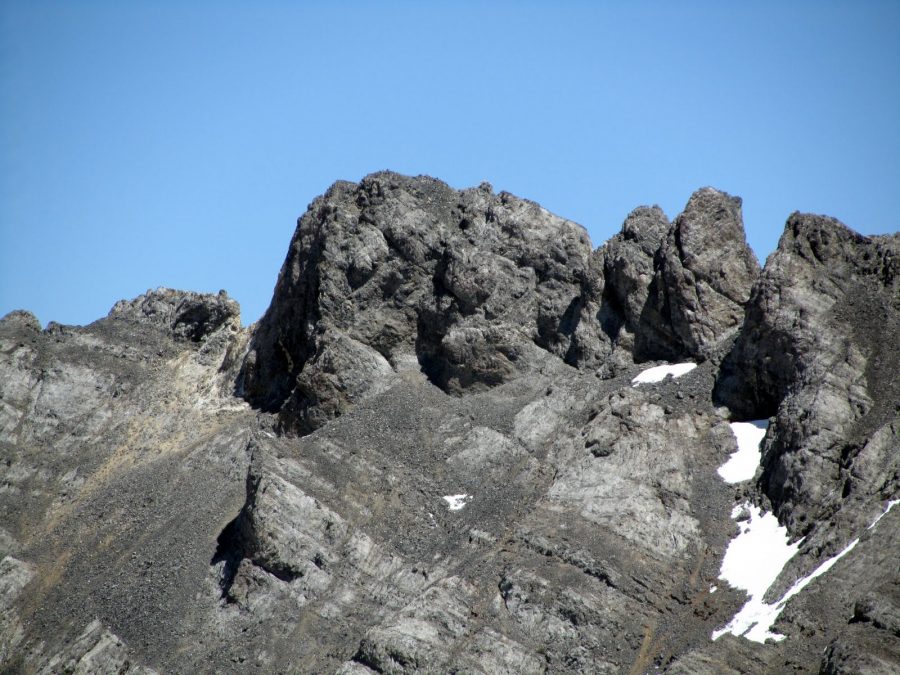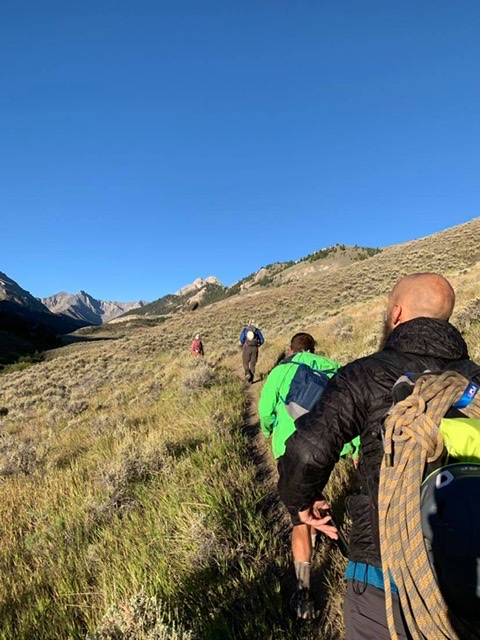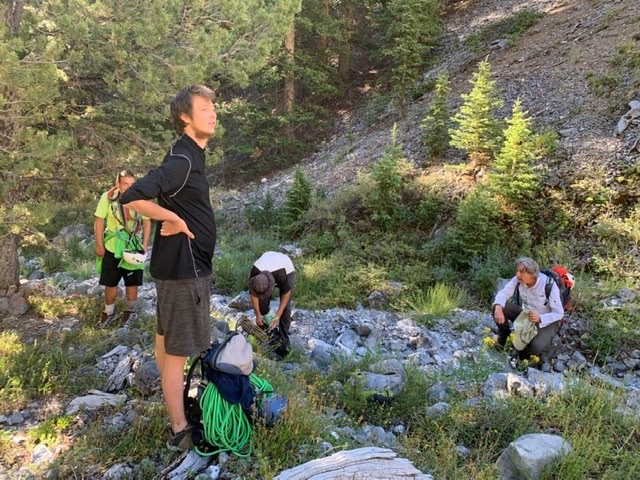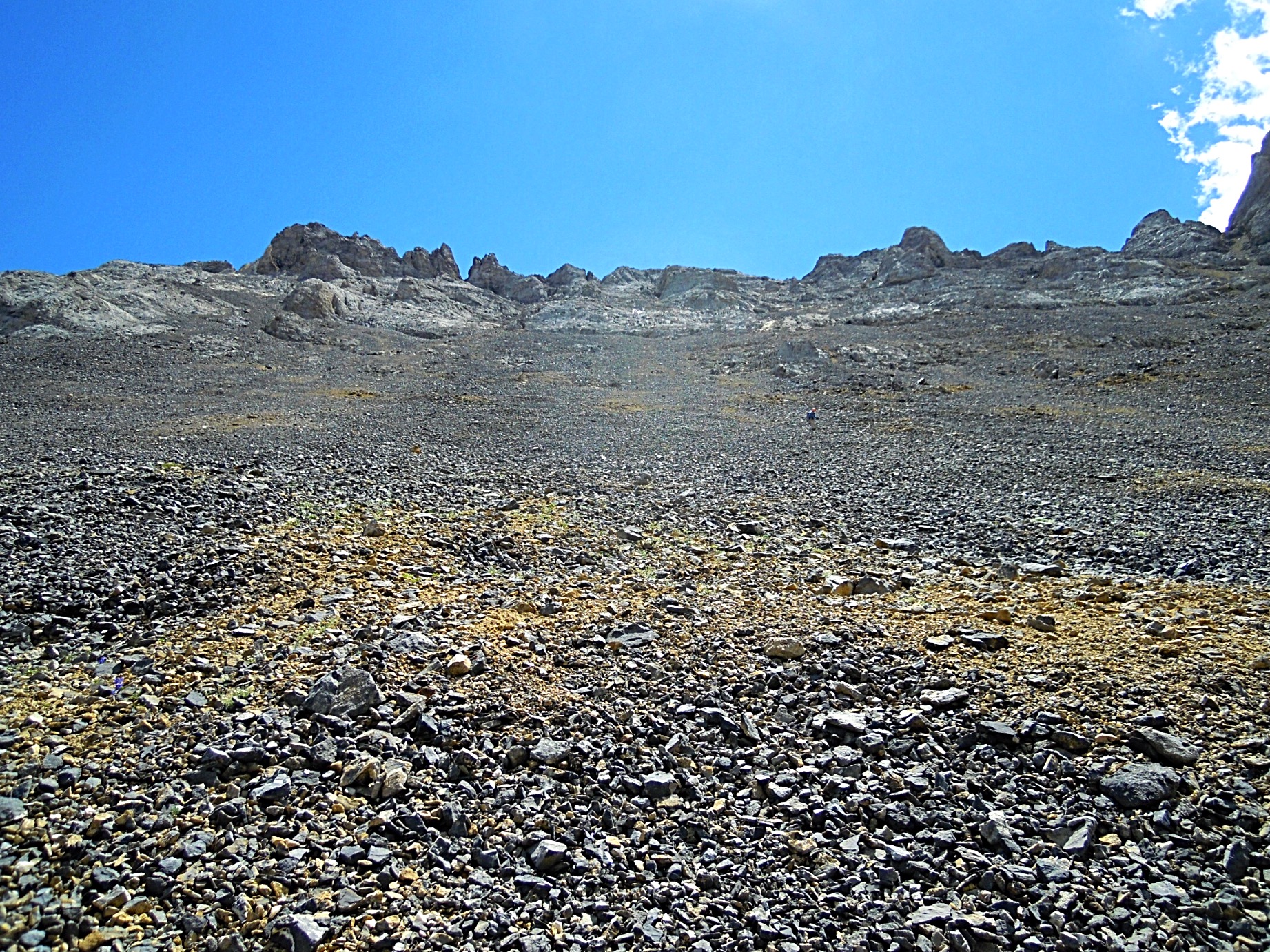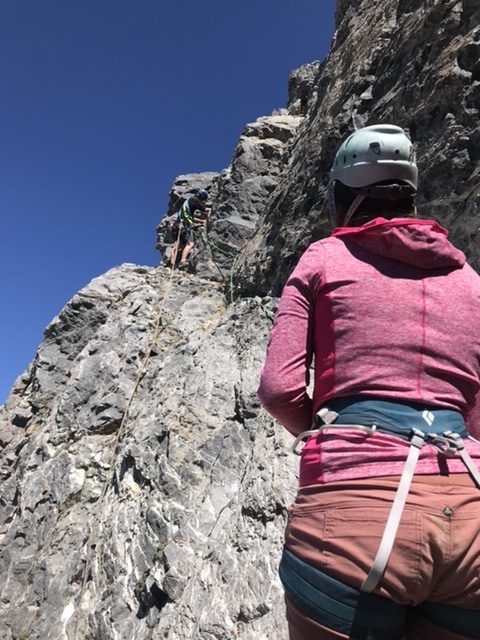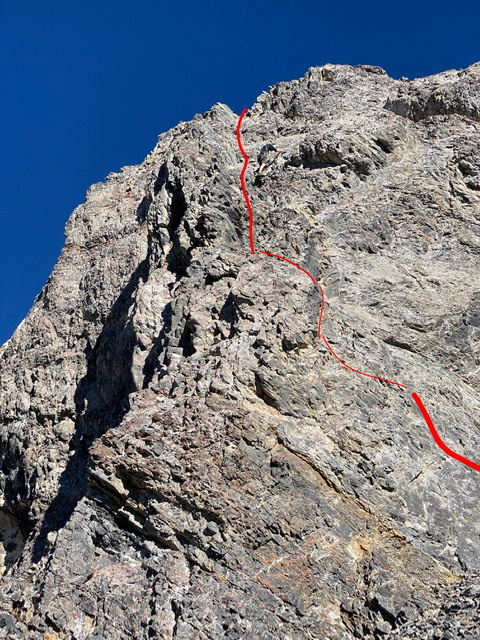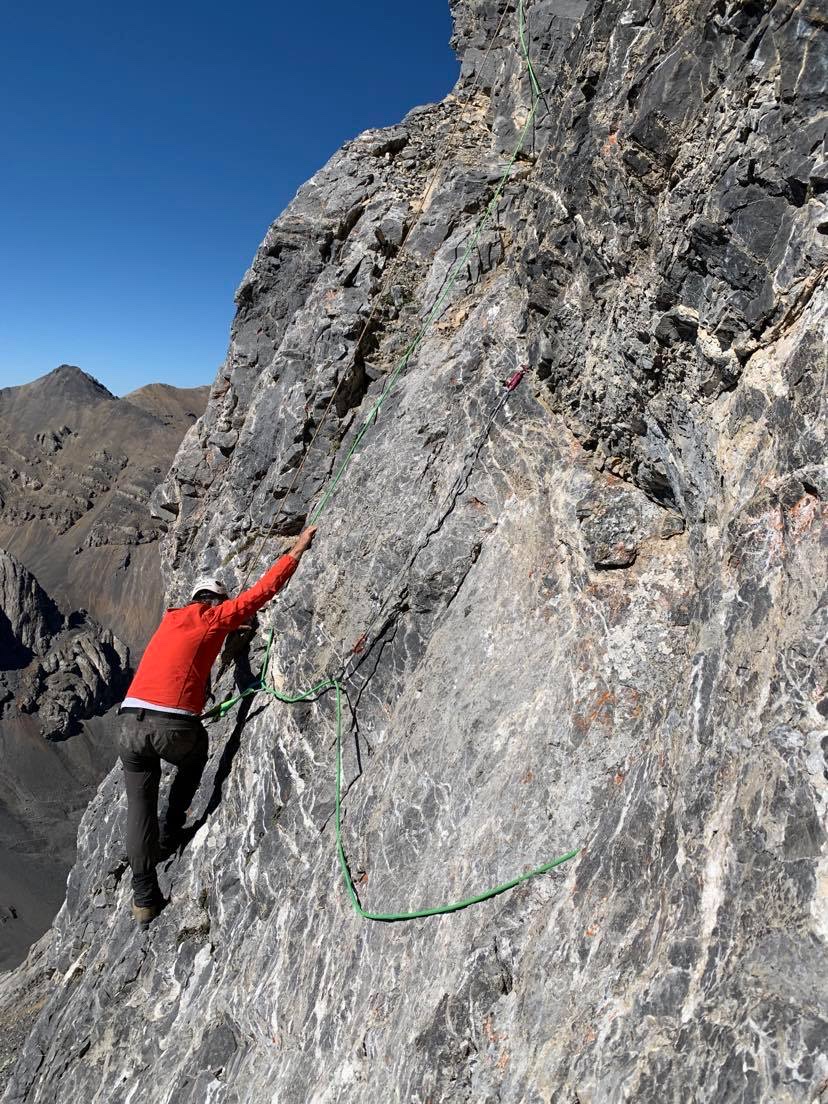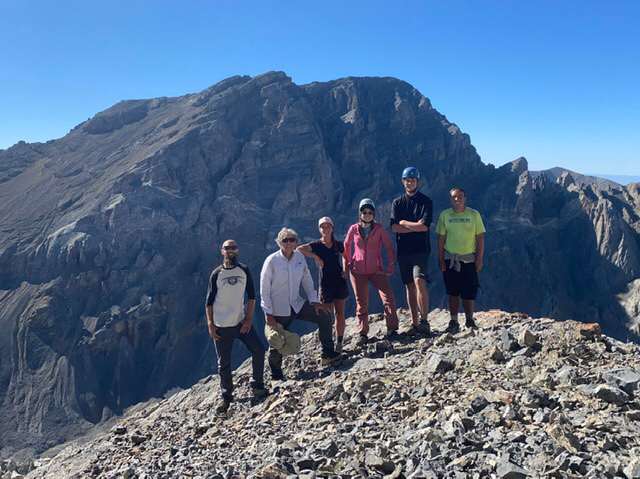This article was first published in Idaho Magazine, April 2021 (Vol. 20, No. 7)
“ROCK!” A shout rang out from above.
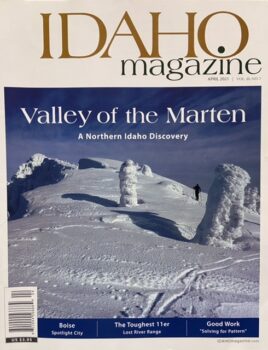 Click, click, clack, bang and then the sound of a rock whizzing through the air was followed by silence. Daniel Todd had dislodged a rock high above us. He was climbing the vertical crack that leads to the summit of True Grit, an Idaho 11,000-foot peak. Climbers are trained to instantaneously warn their partners when they dislodge rock. Daniel’s shout “ROCK” was an instant reminder of the potential dangers ahead.
Click, click, clack, bang and then the sound of a rock whizzing through the air was followed by silence. Daniel Todd had dislodged a rock high above us. He was climbing the vertical crack that leads to the summit of True Grit, an Idaho 11,000-foot peak. Climbers are trained to instantaneously warn their partners when they dislodge rock. Daniel’s shout “ROCK” was an instant reminder of the potential dangers ahead.
I was sitting next to April Watts on a perch at 11,000 feet in the Lost River Range. April was belaying Daniel. We were part of a group of six attempting to climb the only Idaho 11,000-foot peak that has no easy route to its summit. Whether we would reach the summit depended on Daniel, the group’s most proficient technical climber. The rest of our group consisted of Derek Percoski, Haylee Stocking, and Brett Sergenian.
True Grit is located on the south end of the Lost River Range’s treacherous Mount Corruption/Mount Breitenbach Divide. True Grit, along with Triple Peak and Cleft Peak form a rugged cluster of unworldly towers composed of steep, rotten rock. They are difficult to climb and, as a result, are climbed only by truly dedicated Idaho climbers, often referred to as “peakbaggers.”
Peakbaggers are climbers who seek to climb a group of summits categorized or listed by location or height or some other source of significance. Some of the more famous peak lists are the Seven Summits (the highest peaks on each continent), The 14ers (the Colorado peaks which reach above 14,000 feet) and, of course, The 8,000ers (the World’s 14 highest peaks all of which rise above 8,000 meters).
The Idaho 12ers list is undoubtedly the most popular and the most climbed list of Idaho peaks. Nearly 300 climbers have climbed all the 12ers. The Idaho’s County High Point List is probably 2nd in popularity. While many are working on that list, only a handful of people have completed the list. In the Boise area, the Grand Slam Peaks list is a popular goal for local hikers especially in Spring. In the last ten years, climbing all of the 114 Idaho’s peaks that reach above 11,000 feet (but not above 12,000 feet), collectively known as the “11ers” has become “a thing” for peakbaggers. The 11ers are located in six Idaho mountain ranges: the White Clouds, Boulder, Pioneer, Lost River, Lemhi, and Beaverhead ranges. The 11er list, with many remote and treacherous summits, is an extremely challenging list to complete. So far, only nine people have accomplished the feat.
While I had climbed 69 of the 11ers, finishing the list, while something I would find satisfying, was not something I necessarily aspired to accomplish. There are so many Idaho mountains to climb from north to south and east to west. I sometimes feel like a pinball bouncing from peak to peak driven by my wanderlust to explore diverse areas. The more remote, the better. I have been fortunate to have climbed with dozens of great climbers. Suggestions and photos from these climbers more often than not provide my motivation to try a peak.
In the case of True Grit, I ended up with this group of exceptional young climbers at the invitation of Derek Percoski. Derek, Haylee, and Brett climb together often and were all close to becoming the ninth, tenth, and eleventh climbers to complete the 11ers. Derek recognized that because reaching True Grit’s summit required a technical rock climb, they would need the support of experienced rock climbers. While the three were figuratively mountain goats capable of covering immense chunks of difficult mountain terrain, they were not technical climbers.
Derek is by nature a problem solver. He enlisted Daniel, a guide at the Idaho State University Outdoor Adventure Center to lead the climb. Daniel had agreed on the condition that Derek sign up one more experienced technical climber. I am not sure why Derek focused on me but I soon received an email asking if I was interested in joining the group. Of course I was interested. Yet, having climbed with Derek, Brett, and Haylee, I knew how strong and fast they were in the mountains. I also knew I was at a minimum 30 years older than they are. These three have taken Idaho peakbagging to an entire new level. They were not only climbing more peaks in a year than any previous climbers but they were often doing four and five difficult peaks in a day.
True Grit is not only a technical problem, it also involves a long difficult approach. Round trip the climb would cover over 14 miles with nearly 4,000 feet of elevation gain. I knew I could do the distance but I had no fantasies that it would be easy to keep up with them. Getting old is always a conundrum when it comes to my climbing habit—I don’t think of myself as old but I am a realist.
Derek must have sensed my age related hesitancy because he added “I saw you just climbed Alcyon. It is impressive you are still doing hard stuff at your age.” “Ouch,” I thought, “is it that obvious?” Fighting off my hesitancy and following my desire to forestall old age, I agreed to go. We set August 15th for the date. I had a month to “psych” myself up for the ordeal.
I first became aware of True Grit in 2003 when Brian Wright and I made made the first ascent of nearby Triple Peak. We gazed upon True Grit (which was unnamed at that time) which rose menacingly to our east. As convoluted and bad as the rock was on Triple Peak was, the rock on True Grit looked much worse. I must have subconsciously dismissed any thought I had of climbing it because it never came back into my consciousness until I learned of its first ascent.
The name True Grit was bestowed on the peak by its first ascenders: George Reinier, Johnny Roache, and Pat McGrane who climbed it in 2011. Judi Steciak and Carl Hamke made the second ascent. George, Johnny, Judi, and Carl had been locked in a competition to be the first to climb all of the 11ers. George and Johnny won the race and Judi and Carl quickly followed their accomplishment, making Judi the first and only woman to climb all of the 11ers. As a chronicler of Idaho’s mountains, I interviewed the first and second ascenders and learned the details about their climbs. Based on those interviews, I knew True Grit was unquestionably Idaho’s toughest 11er.
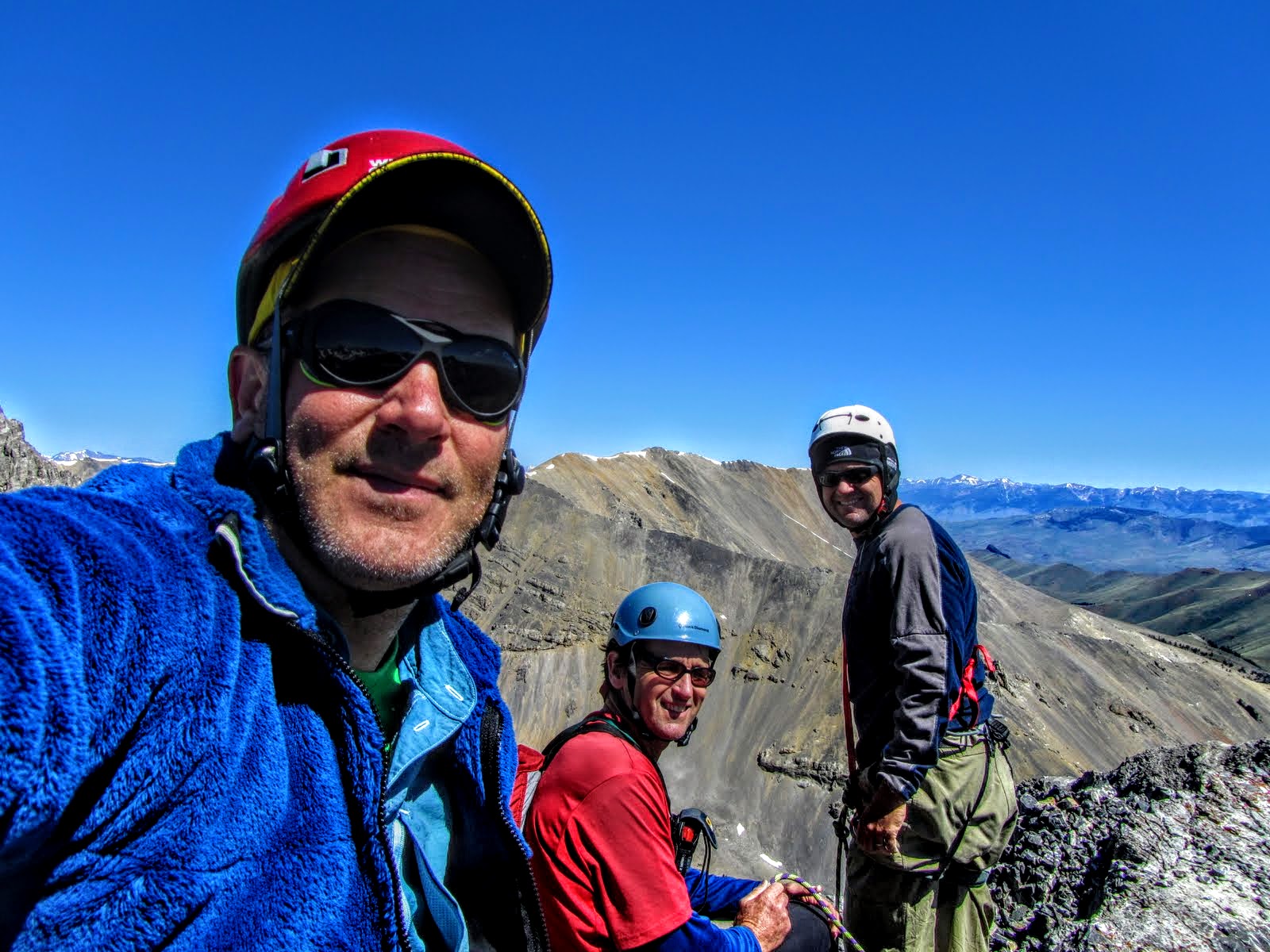
The first ascent team on the summit: George Reinier, Johnny Roache, and Pat McGrane. George Reinier Photo
August 14th arrived. In this time of the COVID pandemic, ride sharing was out of the question. I set off from Boise alone on the five plus hour drive to our meeting place along Dry Creek, a major tributary of the Little Lost River. Dry Creek courses through a spectacular mountain valley surrounded by nine massive Lost River Range peaks topped by 12,000-foot Mount Breitenbach. Given the difficulty of accessing the valley, it is unknown to most Idahoans.
The most interesting man made landmark along Dry Creek the Dry Creek Dam ruin. The dam was blown up as part of a water rights dispute in the 1930s. I followed the rough 4WD road past the ruin and then gritted my teeth. At this point, the road drops precariously off a high bench into the upper Dry Creek drainage. Although I have safely driven this road many times, it still gives me the heebie-jeebies. Inevitably my tires throw gravel and the vehicle tilts distressingly from side to side as it crosses the steep, loose talus slope that serves as a road.
Once the road reaches the bottom of the slope, it fords Long Lost Creek and then reaches the ford of Dry Creek. The sun was dropping behind the the crest of the Lost River Range as I arrived. In the cool of the early evening, I set up my tent surprised that I was the first to arrive. I walked over and looked at Dry Creek, ate dinner, read, and then dropped off to sleep. I woke up when Brett arrived but quickly fell back to sleep.
The rest of the group arrived right on time at six. We loaded up and drove through the creek and on to the end of the road. I had agreed to go along on the condition that someone else would carry my group climbing equipment. So my rope and climbing hardware were quickly claimed by others and we started up the trail at a brisk clip. Not wanting to be a lode stone slowing the group down, I pushed myself.
The Dry Creek Trail has not been maintained for years. Although motor vehicles are no longer permitted beyond the trailhead, in the past, ATVs have driven up the valley creating a walkable tread for roughly two miles where it veeres down to Dry Creek. We continued following the old, sketchy foot path up the valley to roughly 8,200 feet in elevation where we reached the opening of the side canyon that leads up into the cirque between The Cleft and True Grit. “So far, so good,” I thought, “I can keep up with these guys.”
We started up the steep side canyon following the dry stream bottom making occasional detours onto the bench on its south side clambering over loose, slippery rock and over the dead timber deposited by avalanches. I was feeling less spry. At each break, I sat and quietly marshaled my strength. My companions, true endurance climbers, used these breaks to share stories, laugh, and hydrate. Sitting and resting was not something that crossed their minds.
At 9,400 feet, we reached a nearly vertical headwall which we bypassed on the right side of an impressive dry waterfall. Above this headwall, the timber thinned out providing a view of the route ahead. At 10,000 feet, we reached the base of True Grit’s northwest face. From this point, the route climbs up the peak’s northwest face to the summit block 1,000 feet above us. A sea of steep, loose talus stretched before us. Brett was unencumbered by any of the group climbing gear and was soon 500 feet above us effortlessly climbing the talus. We had no idea where he was going but marveled at his climbing motor.
My first encounter with an interminable talus slope was on Oregon’s Mount Theilsen in 1973. Although my first real indoctrination to the “hell” of loose scree and talus was nearly 47 years ago, the struggle with loose talus never gets any easier. It’s one step up, slide back a half step—if you are lucky. If you are unlucky, the loose, moving rock is almost impossible to ascend without grinding continuous effort.
Out of nowhere, Derek offered to carry my daypack up the talus slope. Although my pride told me to decline the offer, I quickly decided this was clearly a case where discretion was the better part of valor. I shook off the embarrassment of giving up my pack in favor of not having to carry the 25-pound pack.
We started up the talus, each of us looking for the path of least resistance. We separated into two groups and suffered mostly in silence. We found the occasional spot where rock outcrops broke through the talus and used these spots to ascend for five or ten feet before plunging back into the talus.
At the top of the talus, we threaded our way up through rubble-covered slabs to the base of the 100-foot tall summit block. The summit block is a fin-shaped wall located at the northeast end of the peak. Brett showed up having covered twice as much ground as us. He had scouted the eastern base of the summit block looking unsuccessfully for other potential undiscovered routes to the top.
The route up the last 100 feet was in front of us just as described by George, Judi, and Pat after their successful climbs. In the world of rock climbing, the route was not technically difficult. It was only one pitch. There were plenty of good hand and foot holds. Still, the route is hazardous. The hazards included the route’s verticality, loose, broken rock, and the lack of places to protect the climb. Daniel and I discussed the best approach to overcoming the technical pitch that loomed above us. In addition to the climbing challenges, we had to figure out how to get everyone to the top.
In brief, technical roped climbing is a well established technique. The lead climber ascends with the rope while a second climber belays the lead climber. The lead climber protects himself by placing protection in the rock as he ascends. The types of protection used might include slings tied around an unmoveable rock, old school pitons pounded into a crack or new school cams or nuts which are wedged into cracks. After the protection is wedged into the rock, the rope is then passed through a carabiner clipped onto the protection. Meanwhile, the belayer must manage the rope as it is pulled up by the lead climber. Most importantly the belayer must be ready to instantly brake the rope if the climber falls. Using this process, the danger to a falling lead climber is minimized as the fall will be limited to twice the distance the lead climber is above the last piece of protection.
It was at this point, that I finally felt like I was not a spare wheel. My climbing experience came into play. Typically, you only climb rock with two or three people on a rope. Any more people would be unmanageable. Daniel’s lead would use the entire length of one rope. Once he was on top the next climber would have to drag our second rope up for the third climber to follow, leaving three climbers without a rope to follow.
So how were we going to manage the climb? It was clear to me we were going to have to take turns with each climber climbing to the top and descending. Daniel instantly volunteered to stay on the summit for the entire time it took to get the rest of us up and down the pitch. Since only Daniel and I had technical climbing experience, I suggested he set our second rope as a fixed line as he climbed. The fixed line would double the protection and lessen the danger presented by the climb.
While Daniel set the belaying anchor I did an abbreviated “Belayed Climbing 101” presentation so that everyone understood the climbing terminology that we would use to communicate between the climber and the belayer while climbing. April volunteered to belay Daniel. Daniel roped up and tied in to the rope. April called “on belay.”
Daniel responded “climbing” and he was off.
Climbers refer to the hardest part of a climb as the crux. On this climb, the crux was the first 50 feet which was a horizontal traverse across a grayish wall of surprisingly hard rock with only small hand- and footholds. The traverse was located above a significant vertical drop. Daniel (a tall, lanky, and talented climber) made short work of the traverse.
After the traverse, we watched Daniel climb a short crack up to a slanting ledge. He followed this ledge to the base of the vertical crack that leads to the summit. At first, this crack is a very shallow, open book-like indentation in the wall. Farther up, the open book flattens out into a wall and steepens. From this point, Daniel finished by climbing three short, rubble-encrusted steps to reach the top of the north ridge. Most of the time, Daniel’s was not visible from the belay station. When he yelled down he was on top, we all let out a cheer.
It was now time to take turns ascending and descending the route. I verified that Brett was properly tied into the climbing rope. Daniel set up an anchor just below the high point and yelled down to Brett “On Belay.” Brett responded “Climbing.” “Climb,” Daniel responded.
When I am leading a difficult route, trepidation is always lingering in the back of my mind. However, following a good lead climber, protected from falling by a rope from above is not nearly as worrisome. Derek, Brett, April, and Haylee would soon experience the confidence a top rope belay brings. Brett, who is both fearless and shorter than Daniel, had to find his own way across the grayish wall traverse using different holds. As we watched Brett move up the route without too much difficulty, I could feel the groups confidence grow. Soon we learned Brett was on the summit, another cheer. Over the next three hours each climber took their turn. Other than knocking loose a few small rocks, there were no problems.
I had offered to the be the last climber. When my turn finally came Daniel put me on belay and I scampered across the grayish wall, up the slanting ledge and then up the crack. “Piece of cake,” I thought. I thanked Daniel for his lead and belay and walked the last few feet to the summit. Still, a climb is not successful until you are safely down. The descent is often the most dangerous part.
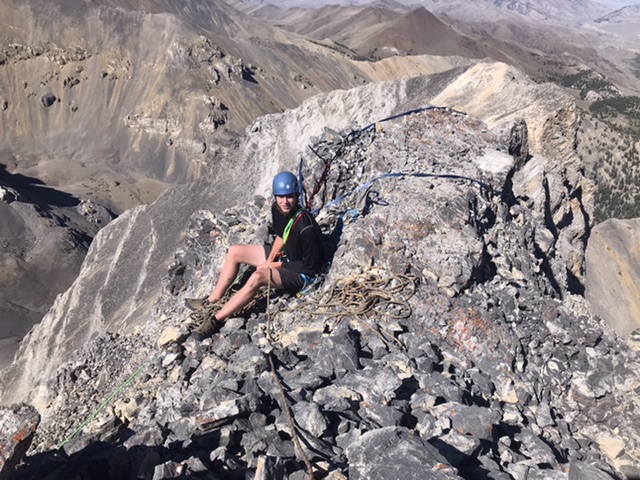
Daniel Todd belaying just below the summit. He was able to set up solid anchor with the use of a lot of sling.
The last person to descend would be in the most danger because they would not be belayed from above. While rappelling down a steep route is the preferred and safest method of descent, there were two problems impacting the rappel option. First, the anchor for the rope relied on broken rock which might give way. If the anchor failed, disaster was sure to follow. Second, the broken, loose rock on the route was another potential hazard. If the rappel rope pulled a rock loose, that rock might cut the rope and, once again, lead to a disaster.
After a short discussion, Daniel decided to down climb the route while we belayed him from below. I had no doubt he was up to the task. I put on the rack holding our remaining climbing protection gear and slings with the idea that I could place more protection as I descended to make the route safer for Daniel. He put me on belay and I moved to the edge. “Holy Smoke,” I said to myself as I looked over the edge. I had climbed up the crack so quickly and easily that I paid no attention to the exposure. At least a 60 foot vertical void stretched below me.
“Well, here goes,” I said as I dropped over the lip. With the rope holding me I was in no danger of falling. As I descended, I kept trying to find a suitable crack to set a cam or a rock I could tie a sling around to make Daniel’s descent safer. My efforts were unsuccessful. The cracks were too wide for our remaining cams. At one point I placed two slings that I had tied together around a big rock horn. When I tested it by putting weight on slings the rock started to move. I yelled back up that I couldn’t place any additional protection. I volunteered Daniel could tie my rope off and rappel down it which would mean we would have to leave the rope. He declined the offer.
Once back at the bottom of the route, we watched Daniel carefully descend the route. Time to celebrate. Derek took a group photo memorializing the day. We started down the 1,000 feet of talus the first leg of the long walk back to trailhead. We arrived at the vehicles on tired legs but with the satisfaction one feels after completing a difficult task.
One week later, Brett Sergenian became the ninth person to complete the 11ers. Haylee Stocking finished 2020 climbing 215 Idaho peaks. She has 20 11ers to go and will undoubtedly complete the list in record time. Derek Percoski climbed 114 Idaho peaks in 2020. He is three peaks short of finishing the 11ers. Daniel Todd continued to expand and share his technical climbing skills with others on Idaho peaks and difficult routes at the City of Rocks. April Watts was interviewed on Idaho Public Television’s Outdoor Idaho episode, The Idaho 12ers. She explained, using her impressive climbing and educational chops, what motivates climbers to risk life and limb to reach a summit.
Me? 2021 is the run up to my 70th birthday. I’m looking forward to a big climbing year.
Next: 5 Kids on Wild Trails by Margaret Fuller
